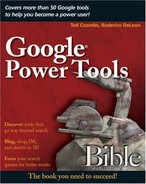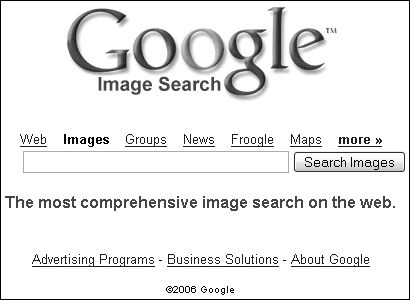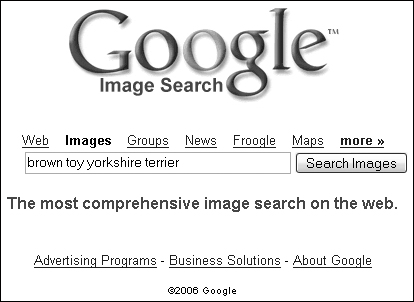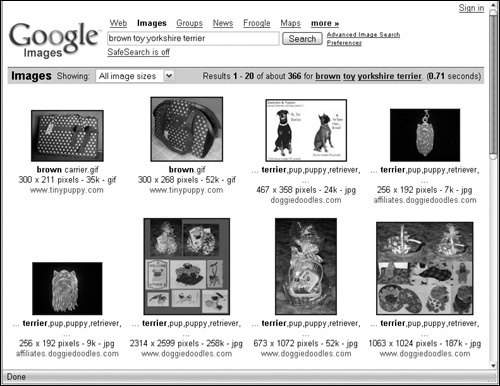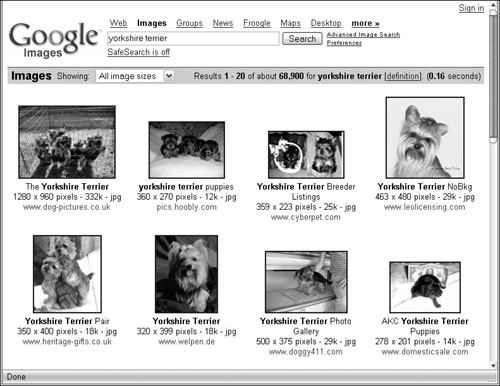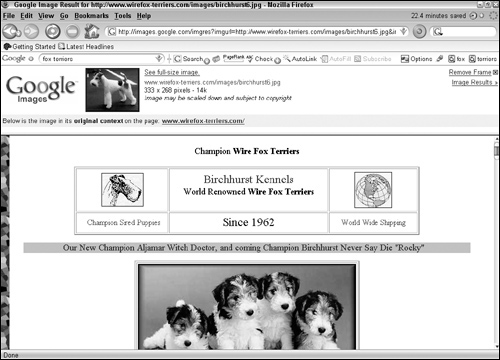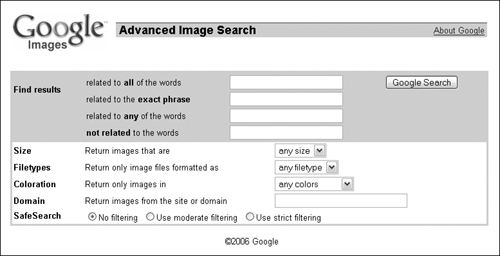Finding images using the Google Image Search page
Creating effective search terms
Viewing images
Using the Advanced Search Features
Eliminating adult content
Copyrighted images
The World Wide Web has always included images. Even before the creation of Mosaic, the first graphic Web browser, you could download and view images from the Web. Today, images are a normal part of the user experience when surfing the Web. The collection of images on the Internet today is truly innumerable. Google has a direct interface to images found on the Internet that are included in Google’s index of Web pages.
Whether you want an image to display on your desktop, create a greeting card for a friend, add graphics to a school or business report, or any other reason, the best method for finding images is using Google’s Image Search. This chapter helps you quickly learn how to find the image you are looking for using the simple interface or the advanced search features. You also learn how to virtually eliminate sexually explicit images from your search results. Finally, this chapter gives you an idea of what rights you have when using an image you download from the Internet.
Begin your image search by navigating from the Google home page to the Google Image Search page by clicking the Images link above the search text box. The Google page reloads and is ready for you to type your search terms (see Figure 4.1).
Successfully finding the images you are looking for requires that you understand how Google searches for images on the Web. Because images are graphics, they do not contain searchable information. Even if the image appears to have text, this text is stored in a graphic format that search engines are not capable of understanding. Therefore, Google searches on any text it can find that might relate to the image you want to find. The search includes image filenames and the HTML <alt> tag description.
Image filenames are the actual names given to the graphic by the people who published the image on the Internet. For example, a picture of someone’s pet might be sammy-poodle.jpg. A search on the word poodle would definitely find this image.
Web page authors can choose to store additional text with their images. This practice started when Internet bandwidth was limited, causing images to load very slowly. People browsing the Web often chose to turn off the loading of images in their browser so that Web pages would load faster. In place of the image, alternate (ALT) text would appear. This text also appears before an image loads into a Web page. You may see this text while you wait for an image to appear in your Web browser. Google then relies only on the image filename to locate images based on your search term.
Google also searches the text of a Web page to see if there are images that match the terms for which you have searched.
Tip
Images returned by finding the search terms on a Web page rather than the image filename or ALT text are not always very relevant. Sometimes it helps to visit the Web page of such an image just to see if there are other images on the Web page that may be more relevant to your search. It does help find Web pages that may have related images. For example, a search on Yorkshire terriers may find Web pages about Yorkshire terriers, but the images may be named Fido.jpg, Sammy.jpg, and Fluffy.jpg.
Finding the image you want among the millions of images stored on the Internet depends on how well you create your search. Too many words in the search terms may limit the search in such a way that you don’t find the image you’re looking for. Or, the search may give you unexpected results. Typing just a few words can mean far too many results to search through. It often takes experimentation to find the right balance. For example, let’s say you are looking for images of Yorkshire terriers, a small dog breed. In particular, you want an image of a brown, toy variety. In the search text box you type brown toy Yorkshire terrier, as shown in Figure 4.2.
The search terms, brown, toy, Yorkshire, and terrier return about 366 images. But, the images that are returned are not what you might expect. Looking at Figure 4.3 you can see that the first two images are of handbags, and the rest of the images in the search results have more to do with jewelry and other gift items.
Scrolling through the results in the Google Image Search it becomes apparent that the search did not result in images of small brown Yorkshire terriers. The next attempt includes fewer search terms, simply Yorkshire terrier.
Tip
Search terms are not case-sensitive. You can type your search terms in lower-, upper-, or mixed case and it will not affect your search results.
The results of the Image Search using only two keywords are shown in Figure 4.4. These results include images of small Yorkshire terriers. Even though it seems a little counterintuitive, by limiting the number of keywords, you have actually narrowed your search.
Create phrases to help limit your searches. Phrases are typed with quotes around them. For example, “Yorkshire terrier” is a phrase that limits your searches to only results containing that exact phrase. So, an image labeled terrier-Yorkshire would not match, but it keeps your searches from returning images of Yorkshire pudding.
Cross-Ref
For more information about limiting searches with operational characters, see Chapter 2.
Once you type a search term in the text box on the Image Search page, press Enter or click Search. Be patient while Google compiles and displays the results.
The results of your image search are displayed as thumbnails, as shown in Figure 4.4. To view an image as something other than a thumbnail, click on the thumbnail in the results page, or click on the URL address displayed below the image’s description. Clicking either the thumbnail or the URL takes you to the Web page where the image is published.
The page that is displayed (see Figure 4.5) contains a top frame, where a slightly larger thumbnail than the one in the search results appears, and a lower frame, where the Web page displays the image as it was published.
The top frame is branded with the Google Images logo. It displays a thumbnail that you can click to view the full-size image by itself on a Web page. The Web page that displays the full-size image will not have a frame or navigational controls. To navigate back to the previous page you need to use your browser’s Back button.
Also displayed in the top frame is the URL of the Web page labeled as the original context. Clicking that link launches the Web page containing the image without the top frame. Again, if you want to navigate back to the Google results after clicking the original context URL, use your browser’s Back button. Another way to view the Web page in its original context is by clicking the Remove Frame link or the X next to the link on the upper-right corner of the top frame. This takes you to the Web page containing the image.
Tip
Clicking links with the right mouse button allows you to select the option to open the link in a new window. This allows you to keep your Google Search results in the original window.
To return to the Image results page click the Image Results link on the right-hand side of the top frame to navigate back to the Google page that displayed your search results as thumbnail images.
Note
Clicking links within the Web page will not remove the top frame. To remove the top frame, either click the original context link or the Remove Frame link.
On a computer that runs Windows, to save, copy, or send an image in e-mail you can right-click on the image and select one of the menu choices from the pop-up menu. On a Macintosh, you Control-click on the image and use the context menu that appears to copy and paste. If your Mac has a two-button mouse try, right-clicking. When saving images for future use, be aware that many images on the Internet are protected by copyright. Please read the section “A Bit About Copyright” later in this chapter before using images you find through Google’s Image Search.
Experimenting with typing the right search terms is one way to achieve your desired search results. A more direct way is to use the Google Advanced Image Search page. Launch the Advanced Image Search page by clicking the Advanced Image Search link next to the Search Images button (see Figure 4.1). You can also launch the Advanced Image Search page from within a results page, as shown in Figure 4.4.
The Advanced Image Search allows you to find results based on the following criteria:
Refined search words and phrases
Image file sizes
Image file types
Image coloration
Web site address or domain
SafeSearch filtering criteria
In the Find Results section of the Advanced Image Search page (see Figure 4.6), there are several ways to filter your search. You can use a single search filter, or you can improve your search by using a combination of filters.
In the related to all of the words text box, you can type search terms that appear anywhere and in any order within the text searched by Google. For example, you can type the terms furry and pest, and they might appear within the ALT text of the image.
In the related to the exact phrase text box, you can type entire phrases that must appear as you have typed them, such as grizzly bear. Any results must have the words grizzly and bear appearing as the phrase grizzly bear. This has the same effect as putting quotes around your phrase in the simple search.
When you use the related to any of the words filter, you can list several search terms and if any of them match the text related to an image, that page appears in your results.
Limit the scope of your search by telling Google which words you do not want to match in your results. Perhaps you are interested in images of grizzly bears, particularly the ones that are pests in national parks, but not interested in bears that inhabit Yosemite National Park. In this example you may want to type the word Yosemite in the not related to the words text box.
You can limit the size of files that appear in your result. There are several reasons why you might want to limit the file sizes. You may be looking for an image of a particular size or quality either for print reproduction, use on your own Web page, or perhaps you want only small images to make download times quicker. The choices for file sizes are small, medium, large, or any size, which is the default.
Another way to filter your search is by specifying the image file type. Only certain image types are viewable using a Web browser, therefore the possible file types are already limited. Google allows you to limit the file types to JPG, GIF, or PNG. If you want to learn more about each of these image file types, type graphic file types explained into a Google Web search.
There are times you may want to find only full-color images and other times when you want black-and-white or grayscale images. Select which image color type you want in the Coloration drop-down list, or use the default, which returns images of any color type.
The Domain text box allows you to limit your search to particular Web sites or Web pages. A domain is a particular Internet site. Each site might contain many Web pages, e-mail addresses, and FTP sites, and may be running many other applications. You can limit your search to a particular domain, such as searching for images on NASA.gov. To limit your search to images found on the NASA domain, type nasa.gov in the Domain text box.
Google understands that its users may want to exclude adult-oriented images from their image search results. A feature known as SafeSearch is provided that uses advanced search algorithms to eliminate most of the adult content. Of course, as Google admits, no attempt at eliminating adult content is going to be completely effective. Google uses a combination of techniques to eliminate adult content in search results, whether searching the Web or searching the Internet for graphic images.
Caution
Parents should be aware that SafeSearch is not a parental control feature. It has no password protection and is easily selected or deselected by people performing searches. It is a feature designed to eliminate adult content by choice.
Google uses the following mechanisms to prevent adult sexual content from ending up in your search results:
Keyword filtering
Phrase checking
Open Directory category matching
Direct input from Google users
Web sites that have deceptive practices, such as using commonly misspelled URLs (Web site addresses) are not allowed in the search results. Deceiving users and tricking them to come to your site expecting one thing but finding another, is a practice known as cloaking. Cloaking can be achieved by registering and using a deceptive domain name and also by using deceptive keywords so that search engines like Google’s register the site in their search engine. It is also possible to send one version of a Web page to a search engine, while sending a completely different version to the user who requests the page. If this happens to you, please report it to Google at http://www.google.com/contact/spamreport.html.
Setting the SafeSearch feature is simple. The SafeSearch options are located in the Advanced Search page of either the text or image search page. The text search allows you to turn SafeSearch on and off by selecting either the No Filtering or Filter using SafeSearch option.
SafeSearch has three selections when searching on images, as shown in Figure 4.5. Select one of the following three SafeSearch filtering levels:
No filtering: This option allows you to search with no SafeSearch filters applied.
Use Moderate Filtering: This option allows you to see Google search results with sexually explicit images eliminated from the results, while allowing results containing sexually explicit words or phrases to appear in the results.
Use Strict Filtering: This option attempts to eliminate search results from Web pages that contain either sexually explicit images or sexually explicit words and phrases or both.
For example, a search on the word playboy without filtering returns images of a sexually explicit nature. Searching with Use Moderate Filtering selected removes images that contain complete nudity. Selecting Use Strict Filtering allows no images to appear from this example search.
Cross-Ref
If you set SafeSearch levels in your Google Global Preferences you can always choose to override them. Learn more in Chapter 2.
There is currently no perfect technology for removing unwanted material from search results. Google does its best to make its search engine Family Safe but makes no promises of perfection. Part of the problem faced by people using the SafeSearch feature is that many Web sites are incorrectly removed from the search results.
Sites removed from search results based on key words might relate to medical, health improvement, news reports or other site that may use a word in a non-sexually explicit manner, but still be filtered based on words or phrases.
The SafeSearch technology is largely based on text search. This type of search is also limited by which languages the search checks. Google text searches for offensive material in English, French, Italian, German, Dutch, or Portuguese, based on which language preference you select.
The Internet is filled with millions of images, many of which have been indexed by Google’s Web crawler. The world’s images are at your fingertips, but be aware that even though you can view the images Google displays, Google does not offer you any rights to use that image.
Governments provide certain rights over the manner in which an idea or information is expressed. Copyright protection covers works such as books, photos, musical works, sound recordings, paintings, software, and designs, but only for a limited time. Copyright is then legal protection for authors and artisans to keep others from copying or using their work without their explicit permission.
Copyright protection is automatically granted whenever something copyrightable is created, whether it is officially registered with the copyright office or not. Once you create something, such as a photo, you are the copyright holder, unless you give those rights to someone else, such as an employer. A copyright holder has the privilege of granting or not granting the right to copy something or if it is a musical or sound recording, the right to play it.
Copyright is protected by both civil and criminal law. Copyright holders can sue someone they believe has infringed on their copyright. In other words, the work was used or copied without permission. Depending on the financial loss and how many copies of the work were created, the person who infringed the copyright may be guilty of a felony.
The bottom line here is that things people create are protected and you must get permission to use other people’s creations. The idea that you can use it for nonprofit purposes freely is not true. No matter how you use it, you need to get permission.
It is always safest to assume that anything you find on the Internet, such as images and Web page content is copyright protected. Before you can use all or part of the work you find, ask for written permission from the owner of the copyright. It’s best not to believe that you can use an original work and not get permission. For example, my grandson has a picture of himself on his Web page wearing a surf helmet and a great smile. One day, I was helping a friend find a dentist locally, and I was stunned to find my grandson’s smiling face staring back at me as part of a dentist locator service Web page. I admit that the likelihood that I would come across that image was remote, but there are organizations that actively search out people violating their copyright.
An original work, as just described, does not have to be registered with the government before it is protected by copyright law. It is protected immediately upon creation. The author, unless commissioned or hired to do the work, is automatically the copyright holder for the original work. When more than one person works on an original work, they are considered co-owners of the copyright.
Sometimes Web pages have a copyright notice, including the year of copyright. Copyright notices will have the word copyright or the copyright symbol (c). Remember, Web pages do not have to have a copyright notice to be protected by copyright; they are protected automatically. A good first place to look for the name of the copyright holder is to look for either a copyright notice or a link to legal information. Some professional Web pages have an entire page dedicated to stating their legal protections.
When you can’t find the name of the copyright holder, such as on a personal Web page, for example, look for the name of the Web page creator. Sometimes this simply appears as a link to the Webmaster, the author of the Web page. In the event that no author information exists on the page, there is one other way you can sometimes find the author, and that is through tracking down the owner of the domain name. You can usually find out the name and sometimes the contact information for domain owners by using the Whois application and most domain registrars like GoDaddy.com. Find the Whois link, and type the domain name of the Web site for which you would like the owner’s name.
When you know the name of the person or organization that holds the copyright to an image, it is best to send a letter documenting your request. Clearly identify the image with a description, and name of the image file. To find the name of the image file you can right-click on the image displayed in your Web browser and choose Properties from the pop-up menu. The filename is usually displayed. In some cases, the filename is masked, and you must describe the image and the URL of the Web page on which you found it. It’s best to simply copy and paste the URL from the address bar in your Web browser.
You can sometimes send an e-mail to the copyright holder, and use the e-mail response as proof of permission. If you are going to use the image for anything other than personal reasons—for example, if you are going to use the image in a book—it is best to have the copyright holder send you a release form. There are sample release forms you can use as a template. Use Google to search on keywords sample copyright release.
In addition to finding people yourself and negotiating the copyright release, there are also commercial services available that will handle this on your behalf. One of those services can be found at www.copyright.com.
Creations such as art, music, drama, and inventions to which no one claims a copyright are held in the public domain. These creations are considered a part of our common cultural heritage and may be used freely by anyone for any reason. For example, many of the images available from the archives of the presidential libraries are public domain.
Cross-Ref
Once you find the image you want to use and obtain permission to use it, consider using Google’s Picasa program to edit the image. Learn more about using Picasa to edit images in Chapter 21.
When researching whether an item of interest is in the public domain, do not confuse it with works offered for free, or open source creations. Open source is covered in more detail in the next section. An author, creator, or inventor may offer his or her work for free while still maintaining the copyright. Offering a work for free does not place it in the public domain. One distinction is that works offered for free may have limits placed on its use. For example, images offered for free but held under copyright may be excluded from use for the promotion of adult or sexual content.
You can find hundreds of sites on the Internet that offer public domain images, either exclusively or as part of their gallery of images. There are many U.S. government Web sites that contain public domain images. For example you might start here: http://www.firstgov.gov/Topics/Graphics.shtml.
Even on the firstgov.gov site there is a warning that even though the images can be freely used, many of them are covered under a license.
Open Source is a philosophy about how intellectual property should be made available to others. Inventions, creations, images, and other intellectual property released as Open Source are covered under a special license agreement. The most common of these is called the GNU public license (www.gnu.org). When the movement first started, it was the exclusive domain of software developers who believed that source code should be made freely available to others to use, and to create derivative works. Later, many other forms of intellectual property were made available as Open Source. Here is one Web site you can access to find open source images: http://openphoto.net/.
You can find additional resource for Open Source images by doing a search in Google on open source images.
A picture is worth a thousand words. It’s probably more like tens or hundreds of thousands of words when you consider the file size of many graphics on the Internet. They are an important part of what has made the World Wide Web what it is today. Prior to the graphic Web browser, the World Wide Web was just one more interesting Internet application along with so many others. Google has provided a unique way to search for images. No other search engine has this type of search, and certainly not with the capabilities, using the Google Advanced Image Search, for finding just the right image.
Understanding the way in which images are distributed is very important. You need to know whether the image you’ve found can be copied. Most organizations allow you to use their copyrighted photos if you pay a license fee. There are many others that are public domain or offered under the guidelines and licensing of Open Source.
